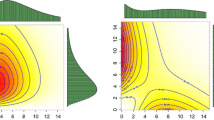Abstract
If follow-up is made for subjects which are grouped into units, such as familial or spatial units then it may be interesting to test whether the groups are homogeneous (or independent for given explanatory variables). The effect of the groups is modelled as random and we consider a frailty proportional hazards model which allows to adjust for explanatory variables. We derive the score test of homogeneity from the marginal partial likelihood and it turns out to be the sum of a pairwise correlation term of martingale residuals and an overdispersion term. In the particular case where the sizes of the groups are equal to one, this statistic can be used for testing overdispersion. The asymptotic variance of this statistic is derived using counting process arguments. An extension to the case of several strata is given. The resulting test is computationally simple; its use is illustrated using both simulated and real data. In addition a decomposition of the score statistic is proposed as a sum of a pairwise correlation term and an overdispersion term. The pairwise correlation term can be used for constructing a statistic more robust to departure from the proportional hazard model, and the overdispesion term for constructing a test of fit of the proportional hazard model.
Similar content being viewed by others
References
O. O. Aalen, “Heterogeneity in survival analysis,”Statist. Med. vol. 7 pp. 1121–1137, 1988.
P. K. Andersen, Ø. Borgan, R. D. Gill and N. Keiding,Statistical Models Based on Counting Processes, Springer-Verlag: New York, 1993.
J. R. Batchelor and M. Hackett, “HLA matching in treatment of burned patients with skin allografts,”Lancet vol. 2 pp. 581–583, 1970.
N. E. Breslow, “Covariance analysis of censored survival data,”Biometrics vol. 30 pp. 89–99, 1974.
D. G. Clayton, “A model for association in bivariate life-tables and its application in epidemiological studies of family tendency in chronic disease incidence,”Biometrika vol. 65 pp. 141–151, 1978.
D. G. Clayton and J. Cuzick, “Multivariate generalizations of the proportional hazards model (with discussion),”J. Roy. Statist. Soc. A vol. 148 pp. 82–117, 1985.
D. Commenges and P. K. Andersen, “Score test of homogeneity for survival data,” Research Report 93/5, Statistical Research Unit, University of Copenhaguen, 1993.
D. Commenges, L. Letenneur, H. Jacqmin, T. Moreau, and J.-F. Dartigues, “Test of homogeneity of binary data with explanatory variables,”Biometrics vol. 50 pp. 613–620, 1994.
D. R. Cox, “Partial likelihood,”Biometrika vol. 66 pp. 269–276, 1975.
D. R. Cox, “Some remarks on overdispersion.’Biometrika vol. 70 pp. 269–74, 1983.
C. B. Dean, “Testing for Overdispersion in Poisson and Binomial Regression Models,”Journal of the American Statistical Association vol. 87 pp. 451–457, 1992.
T. R. Fleming and D. P. Harrington,Counting Processes and Survival Analysis Wiley: New York, 1991.
R. J. Gray, “Test for Variation Over Groups in Survival Data,”Journal of the American Statistical Association vol. 90 pp. 198–203, 1995.
P. Hougaard, “A class of multivariate failure time distributions,”Biometrika vol. 73 pp. 671–678, 1986.
H. Jacqmin and D. Commenges, “Tests of Homogeneity for Generalized Linear Models,”Journal of the American Statistical Association, in press.
D. Y. Lin and L. J. Wei, “Goodness-of-Fit Tests for the General Cox Regression Model,”Statistica Sinica vol. 1 pp. 1–17, 1991.
G. G. Nielsen, R. D. Gill, P. K. Andersen, and T. I. A. Sørensen, “A counting process approach to maximum likelihood estimation in frailty models,”Scand. J. Statist. vol. 19 pp. 25–43, 1992.
V. S. Perkel, M. H. Gail, J. Lubin, D. Y. Pee, R. Weinstein, E. Shore-Freeman and A. B. Schneider, “Radiation-induced thyroid neoplasms: Evidence for familial susceptibility factors,’J. Clin. Endocrin. and Metabolism vol. 66 pp. 1316–1322, 1988.
R. L. Prentice and S. G. Self, “Contribution to the discussion of the paper by D. G. Clayton and J. Cuzick,”J. Roy. Statist. Soc. A vol. 148 pp. 112–113. 1985.
J. W. Vaupel, K. G. Manton and E. Stallard, “The impact of heterogeneity in individual frailty on the dynamics of mortality,”Demography vol. 16 pp. 439–454, 1979.
J. W. Vaupel and A. I. Yashin, “Heterogeneity ruses: some surprising effects of selection on population dynamics,”Amer. Statist. vol. 39 pp. 176–185, 1985.
Author information
Authors and Affiliations
Rights and permissions
About this article
Cite this article
Commenges, D., Andersen, P.K. Score test of homogeneity for survival data. Lifetime Data Anal 1, 145–156 (1995). https://doi.org/10.1007/BF00985764
Received:
Accepted:
Issue Date:
DOI: https://doi.org/10.1007/BF00985764




